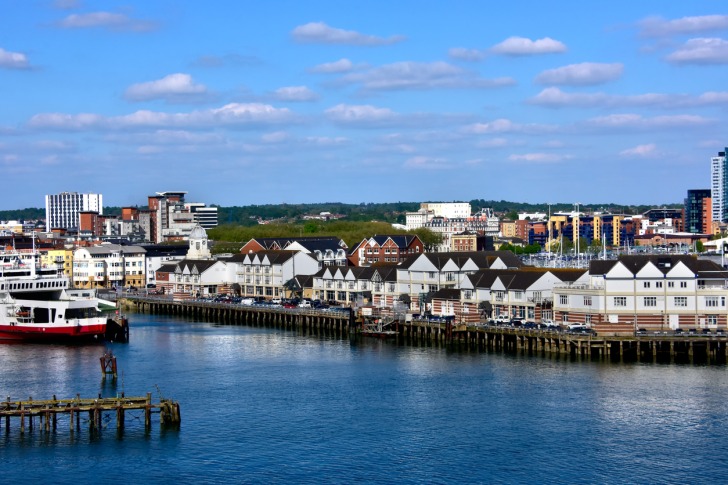 United Kingdom : Safety by City
United Kingdom : Safety by City
- Aberdeen
- Bath
- Belfast
- Birmingham
- Bradford
- Brighton
- Bristol
- Cambridge
- Canterbury
- Cardiff
- Coventry
- Dundee
- Edinburgh
- Exeter
- Glasgow
- Inverness
- Leeds
- Leicester
- Liverpool
- London
- Manchester
- Newcastle upon Tyne
- Northern Ireland
- Nottingham
- Oxford
- Peterborough
- Salford
- Scotland
- Sheffield
- Southampton
- Surrey
- York
Southampton is a port city located in Southern England.
It’s located about 80 miles south of London.
There’s plenty to do throughout the town, making it a great place to stop for a day or two.
History lovers may know that the Titanic set off for its first and last voyage from Southampton Port.
Today, there’s a SeaCity Museum with an interactive model of the ill-fated ship.
Over the years, the port has launched Ocean Liners, and today is a popular port for cruise ships.
The area’s first residents were Stone Age people before the Romans invaded and Native Britons were forced to flee decades later.
Southampton Castle was constructed in the 12th century.
The area’s rich history, proximity to London, and bustling port status are key to its popularity with tourists.
Warnings & Dangers in Southampton

OVERALL RISK: MEDIUM
Southampton is considered one of the most dangerous cities in the U.K. However, this statistic doesn't show the entire picture. Southampton is much safer than London and is generally considered a safe city to visit. It's also important to note that safety is relative. Southampton may be dangerous when compared to many cities in the U.K., but it's safer than the average city in the U.S.

TRANSPORT & TAXIS RISK: LOW
Taxis and other forms of transportation are safe in Southampton. Taxis and rideshare services are safe, with strict regulations for drivers. A new law uses a database to prevent drivers from going to a new area and getting a taxi license after losing their license in another area due to poor or reckless driving.

PICKPOCKETS RISK: MEDIUM
Pickpocketing is a risk in Southampton. The rate of pickpocketing is 1.25, compared to only .6 in Hampshire. This means you are 102% more likely to have your pockets picked in Southampton than in Hampshire as a whole. There were 328 incidents of pickpocketing last year. It's far from the most common crime, but it does occur.

NATURAL DISASTERS RISK: LOW
Natural disasters aren't common in Southampton, but flooding is a concern. Approximately 10% of the city is currently at risk for tidal flooding. As climate change occurs, this is expected to increase. Flooding is also the most common weather-related natural disaster risk throughout the U.K. The city's Environment Agency is currently working to develop an infrastructure plan to reduce the risk.

MUGGING RISK: LOW
Robbery, including mugging, is slightly less common than pickpocketing. There were 308 incidents reported last year, which gives Southampton a rate of 1.14. The rate for Hampshire is .62, making Southampton 82% more dangerous than Hampshire. However, the rate is still relatively low, which is why we've given the city a low risk in this area.

TERRORISM RISK: MEDIUM
Terrorist attacks are not common in Southampton. However, the current terrorism threat level for the UK is substantial, which means that an attack is likely. Terrorism threats can be international or national.

SCAMS RISK: MEDIUM
Scams are a problem all over the world, and Southampton is no exception. Scams can include email, social media, text, and phone calls that ask you to send money or provide your personal information. You may also encounter door-to-door scams. The scammer may offer to do your shopping or decontaminate your home. Once they are paid, they disappear with your cash.

WOMEN TRAVELERS RISK: HIGH
The risk to women is considered high due to the high number of violent and sexual crimes. Women should not travel alone in the area and should avoid walking alone at night specifically. The rate of violence and sexual crime in Southampton was 59.56, with a total of 16,065 crimes last year. This is 52% higher than the rate for Hampshire. Much of this is due to domestic violence, but the rate is still concerningly high. This type of crime occurs 3 to 4 times more often than any other type of crime in the city.

TAP WATER RISK: LOW
The risk of tap water contamination in Southampton is very low, given the strict national and local guidelines. The water in the UK ranks as one of 6 countries with a perfect score on the 2022 Environmental Performance Index, which means Southampton residents enjoy some of the best water in the world.
Safest Places to Visit in Southampton
While Southampton does have a concerning crime rate, it’s typically concentrated in certain areas.
The upscale areas are generally safe, while lower-income areas have a higher rate of crime.
The safest neighborhoods in Southampton are Bassett Green, Highfield & University, and Sholing East.
Places to Avoid in Southampton
The most dangerous area of Southampton is Central Southampton West, with a crime rate of 366.
There were a total of 4,065 crimes in the neighborhood last year.
Newtown & Nicholstown, Freemantle, and Shirley Warren are next on the list.
Central Southampton East is 5th, with a crime rate of 186.
Safety Tips for Traveling to Southampton
- Be Aware of Your Surroundings. The first safety tip is to simply be aware of your surroundings. It’s easy to get caught up in the sights and magic of the place and forget to be vigilant. Keep an eye out for anyone acting suspicious, and know what is going on around you at all times when you are out in public.
- Follow Local Laws and Customs. This is easily overlooked, but it’s important to be sure that you stay on the right side of the law. Smoking and drinking on the streets are illegal. There are also strict rules about driving in Southampton. Be aware of any local laws and customs before you go, so you don’t run into unexpected trouble that could have been avoided.
- Prevent Pickpocketing. Pickpocketing isn’t particularly common in Southampton, but when it does occur tourists are often the target. There are a few steps you can take to avoid this issue. Never put valuables into your back pocket, it’s easy to steal. Zippered, buttoned, or hidden pockets provide much more security. Today, you can find everything from tank tops to underwear with clever hidden pockets, these are a great way to protect your cash. If this isn’t an option, front pockets are more secure than back pockets. You can also wear a money belt. If you carry a purse, wear it cross-body.
- Don’t Look Like a Tourist. Do your best to avoid looking like a tourist. Look like you have an idea where you are going. Walk with confidence. Avoid flashy clothing or wearing valuables like expensive jewelry, and don’t flash large amounts of cash. Tourists are seen as easy targets.
- Guard Your Belongings. Only bring what you truly need, particularly when it comes to things you don’t want to lose. This helps protect important items and reduces your stress. Never leave valuables unattended in your hotel room. Don’t sit your purse, wallet, phone, or other important items down anywhere in public. It’s easy to forget them and also makes it easy for someone to grab them.
- Travel With a Group. It’s always a good idea to travel with others. Going out in groups or with a partner gives you an added bit of security, because solo travelers, or solo people in general, are easier targets. If you must travel alone, stay in well-populated areas. Avoid places that are deserted or have few people.
- Keep Personal Information Private. Be careful about who you give your personal information to. If an official needs to see documents, ask to see their credentials before providing them. Keep items like your passport or bank card on you at all times. Keep your phone locked. If it’s lost or stolen, it can provide lots of personal information if it’s left unlocked.
- Sign up for STEP. STEP, or Smart Traveler Enrollment Program, is a service provided by the U.S. government for travelers. When you sign up, you’ll be registered with the local U.S. Embassy. You’ll get notifications about any security threats or natural disasters. It also makes it easier to be reached in an emergency. The program is free, so there’s no downside to using it.
- Have an Emergency Plan. Emergency plans are a great idea regardless of where you are. You should have a plan in place for different types of emergencies, like power outages and sudden illnesses. You also need a plan if you need to travel home very quickly. Your plan should include phone numbers for local authorities and the U.S. Embassy.
- Stay in Touch with Loved Ones. This is the same advice given to hikers. Make sure someone knows where you are, and when they will hear from you. If they don’t hear from you, they should assume something is wrong and contact the local authorities. If you are traveling with companions, they can be your primary contact. However, it’s still smart to stay in touch with someone at home as well.
So... How Safe Is Southampton Really?
Southampton does have significantly more crime than Hampshire.
It’s also much higher than the national average.
Crime in Southampton occurs 112% more often than the national average, with an overall crime rate of 40.2.
38% of all crimes committed are violent, which is also concerning.
However, Southampton is fairly safe when compared to London.
The crime rate for London is 100.9, and London City’s rate was an incredible 819.
If you are accustomed to living in a high crime area like London or many American cities, Southampton will seem safe by comparison, despite the crime rate being double the national average.
It’s also important to note that most crime in Southampton likely happens between people who know each other and isn’t directed at tourists.
You should be safe in Southampton, as long as you follow common sense tips and advice.
How Does Southampton Compare?
| City | Safety Index |
|---|---|
| Southampton | 65 |
| Cambridge | 78 |
| Brighton | 67 |
| Canterbury | 79 |
| Bradford | 42 |
| Sheffield | 74 |
| Surrey | 77 |
| Deadwood (United States) | 80 |
| Sturgis (United States) | 80 |
| Pierre (United States) | 81 |
| Spearfish (United States) | 80 |
| Hill City (United States) | 83 |
| Temuco (Chile) | 31 |
Useful Information

Visas
If you are a U.S. citizen, you won't need a visa if you are visiting for less than 6 months. You will need your passport. The UK is implementing an ETA, or Electronic Travel Association program. Once this is in place, you'll need to apply for an ETA online before your visit. You'll need your passport and personal information when applying. There is a fee for this, but it's expected to be around $10.

Currency
The currency in the UK is The Pound Sterling, or the Great British Pound (GBP). American currency isn't widely accepted out of airports. You can exchange your currency at banks, post offices, or American Express locations.

Weather
The weather in Southampton is relatively mild. Summer temperatures reach about 70 degrees, and winter temps are rarely below freezing. The rainiest months are November, January, and February. The chance of rain is greater than 50% during these times.

Airports
Southampton Airport is an International Airport located in Southampton. It's a midsized airport with flights to 19 destinations.

Travel Insurance
Travel insurance is recommended before heading to Southampton. One type of travel insurance is health coverage. This covers any emergency medical expenses you have while abroad. You can also get coverage for delays, cancellations, and lost luggage. This can give you peace of mind when you are traveling, which is well worth the cost. All-in-one travel coverage will protect you from nearly any issue that might arise during your trip.
Southampton Weather Averages (Temperatures)
Average High/Low Temperature
| Temperature / Month | Jan | Feb | Mar | Apr | May | Jun | Jul | Aug | Sep | Oct | Nov | Dec |
|---|---|---|---|---|---|---|---|---|---|---|---|---|
| High °C |
8 | 8 | 11 | 14 | 17 | 20 | 22 | 21 | 19 | 15 | 11 | 9 |
| Low °C |
3 | 3 | 4 | 5 | 8 | 11 | 13 | 13 | 10 | 8 | 5 | 3 |
| High °F |
46 | 46 | 52 | 57 | 63 | 68 | 72 | 70 | 66 | 59 | 52 | 48 |
| Low °F |
37 | 37 | 39 | 41 | 46 | 52 | 55 | 55 | 50 | 46 | 41 | 37 |
United Kingdom - Safety by City
| City | Safety Index |
|---|---|
| Aberdeen | 63 |
| Bath | 81 |
| Belfast | 56 |
| Birmingham | 44 |
| Bradford | 42 |
| Brighton | 67 |
| Bristol | 58 |
| Cambridge | 78 |
| Canterbury | 79 |
| Cardiff | 64 |
| Coventry | 41 |
| Dundee | 60 |
| Edinburgh | 70 |
| Exeter | 77 |
| Glasgow | 55 |
| Inverness | 73 |
| Leeds | 56 |
| Leicester | 43 |
| Liverpool | 56 |
| London | 68 |
| Manchester | 44 |
| Newcastle upon Tyne | 72 |
| Northern Ireland | 56 |
| Nottingham | 56 |
| Oxford | 66 |
| Peterborough | 70 |
| Salford | 43 |
| Scotland | 71 |
| Sheffield | 74 |
| Southampton | 65 |
| Surrey | 77 |
| York | 83 |











